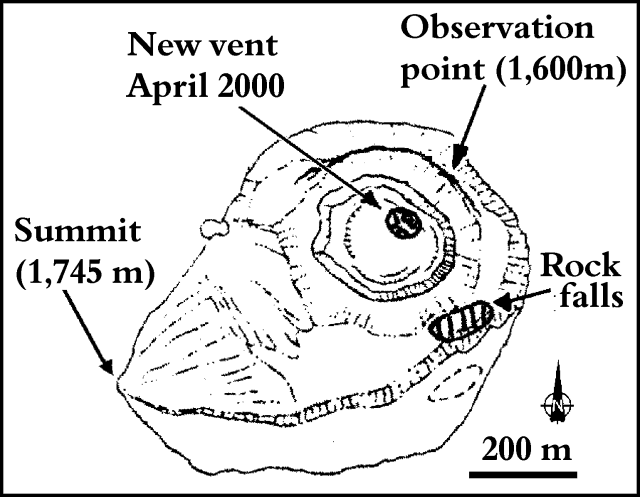Report on San Cristobal (Nicaragua) — May 2000
Bulletin of the Global Volcanism Network, vol. 25, no. 5 (May 2000)
Managing Editor: Richard Wunderman.
San Cristobal (Nicaragua) Emissions decreased in March; several lahars occurred in May
Please cite this report as:
Global Volcanism Program, 2000. Report on San Cristobal (Nicaragua) (Wunderman, R., ed.). Bulletin of the Global Volcanism Network, 25:5. Smithsonian Institution. https://doi.org/10.5479/si.GVP.BGVN200005-344020
San Cristobal
Nicaragua
12.702°N, 87.004°W; summit elev. 1745 m
All times are local (unless otherwise noted)
In May 2000 a series of lahars at San Cristóbal mobilized ash that had been deposited on the volcano from the 20 November 1999 eruption (BGVN 25:02) and from sporadic ash-and-gas emissions during November to May.
In March 2000 the number of ash-and-gas emissions decreased from levels in February. The number of seismic events also substantially decreased from 1,748 in February to 181 in March, but seismic tremor remained high. Two noteworthy seismic events occurred on 15 March at 1200 and 1311. One was felt by settlers who live on the volcano's flanks and by observers on Casita's summit.
INETER personnel noted that ash emissions from the volcano's secondary crater continued in March. They observed a large number of fumaroles that surrounded the internal wall of the secondary crater. The fumaroles were determined to have a maximum temperature of 120 °C using a hand-held infrared sensing instrument. On 19 and 20 March Pierre Delmelle (Université de Montréal) and Julio Alvarez (INETER - GEOFISICA) performed COSPEC measurements near the volcano that yielded SO2 fluxes of 352-1,644 tons/day, with an average value of 873 tons/day. Activity during April was similar to March with sporadic gas-and-ash emissions.
Just after the beginning of the rainy season on 13 May, lahars traveled down the flanks of the volcano to the N, NW, and S. INETER seismologists detected the lahars in progress using two seismic stations located S and SW of the volcano. The lahars were small, traveled long distances, and were not considered dangerous because they traveled within channels and caused no destruction to populated areas. The deposited material consisted partly of volcanic ash that had accumulated since the ongoing eruption began in November 1999. The average thickness of the deposited material was 30 cm and the total volume was 275,000 m3.
After strong local rains on 17 May, lahars similar to the 13 May lahars traveled down the slopes of San Cristóbal to the NW and SW. The thickness of the deposited material was 30-35 cm, and the volume was between 25,000 and 200,000 m3. In addition, on 19 May lahars traveled to the N, SW, and S.
On 30 April Alain Creusot observed the new crater for 4 hours from the NE crater rim (figure 8). He noted that 2 to 4 million m3 of ash was deposited at the summit area. He also found the crater was 200 m deep, which was 50 m deeper than when it was observed in January. In addition, a new vent had opened in the crater to the NE. The change in the crater's depth indicated that 4 to 5 million m3 of lithic ash had been ejected. Rhythmic phreatic explosions reached an altitude of 500-600 m and a permanent jet-like noise was heard from steam-and-gas emissions. Rock fall activity was concentrated to the SE of the old crater.
 |
Figure 8. Sketch map of the San Cristóbal summit area showing the new vent within the crater and the location of recent rock falls. Courtesy of Alain Creusot. |
During a visit on 22 June he found the 2-4 million m3 ash deposit at the summit had been washed mainly down the volcano's SW slope by rain. The new crater had been refilled to an approximate depth of 150 m. Fumaroles in the old part of the crater were measured to be 200-250 °C, and 500-600 °C in the crater's deep part. Steam-and-gas emissions continued to produce a loud noise.
Geological Summary. The San Cristóbal volcanic complex, consisting of five principal volcanic edifices, forms the NW end of the Marrabios Range. The symmetrical 1745-m-high youngest cone, named San Cristóbal (also known as El Viejo), is Nicaragua's highest volcano and is capped by a 500 x 600 m wide crater. El Chonco, with several flank lava domes, is located 4 km W of San Cristóbal; it and the eroded Moyotepe volcano, 4 km NE of San Cristóbal, are of Pleistocene age. Volcán Casita, containing an elongated summit crater, lies immediately east of San Cristóbal and was the site of a catastrophic landslide and lahar in 1998. The Plio-Pleistocene La Pelona caldera is located at the eastern end of the complex. Historical eruptions from San Cristóbal, consisting of small-to-moderate explosive activity, have been reported since the 16th century. Some other 16th-century eruptions attributed to Casita volcano are uncertain and may pertain to other Marrabios Range volcanoes.
Information Contacts: Wilfried Strauch and Virginia Tenorio, Department of Geophysics, Instituto Nicaragüense de Estudios Territoriales (INETER), P.O. Box 1761, Managua, Nicaragua (URL: http://www.ineter.gob.ni/); Alain Creusot, Instituto Nicaraguense de Energía, Managua, Nicaragua (URL: http://www.ine.gob.ni/).

